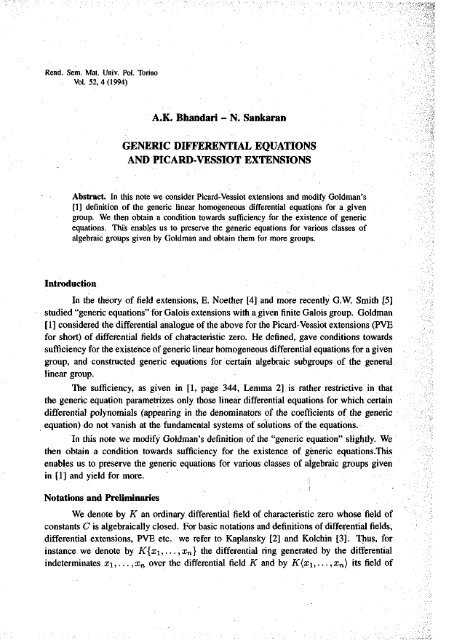Rend. Sem. Mat. Univ. Poi. Torino Voi. 52,4(1994) - Seminario ...
Rend. Sem. Mat. Univ. Poi. Torino Voi. 52,4(1994) - Seminario ...
Rend. Sem. Mat. Univ. Poi. Torino Voi. 52,4(1994) - Seminario ...
- No tags were found...
You also want an ePaper? Increase the reach of your titles
YUMPU automatically turns print PDFs into web optimized ePapers that Google loves.
<strong>Rend</strong>. <strong>Sem</strong>. <strong>Mat</strong>. <strong>Univ</strong>. <strong>Poi</strong>. <strong>Torino</strong><strong>Voi</strong>. <strong>52</strong>,4(<strong>1994</strong>)A.K. Bhandari - N. SankaranGENERIC DIFFERENTIAL EQUATIONSAND PICARD-VESSIOT EXTENSIONSAbstract. In this note we considér Picard-Vessiot extensions and modify Goldman's[1] defìnition of the generic linear homogeneous differential equations for a givengroup. We then obtain a condition towards sufficiency for the existence of genericequations. This enables us to preserve the generic equations for various classes ofalgebraic groups given by Goldman and obtain them for more groups.IntroductionIn the theory of field extensions, E. Noether [4] and more recently G.W. Smith [5]studied "generic equations" for Galois extensions with a given finite Galois group. Goldman[1] considered the differential analogue of the above for the Picard-Vessiot extensions (PVEfor short) of differential fields of characteristic zero. He defined, gave conditions towardssufficiency for the existence of generic linear homogeneous differential equations for a givengroup, and constructed generic equations for certain algebraic subgroups of the generallinear group.The sufficiency, as given in [1, page 344, Lemma 2] is rather restrictive in thatthe generic equation parametrizes only those linear differential equations for which certaindifferential polynomials (appearing in the denominators of the coefficients of the genericequation) do not vanish at the fundamental systems of solutions of the equations.In this note we modify Goldman's defìnition of the "generic equation" slightly. Wethen obtain a condition towards sufficiency for the existence of generic equations.Thisenables us to preserve the generic equations for various classes of algebraic groups givenin [1] and yield for more.Notations and PreliminariesWe denote by K an ordinary differential field of characteristic zero whose field ofconstants C is algebraically closed. For basic notations and defìnitions of differential fields,differential extensions, PVE etc. we refer to Kaplansky [2] and Kolchin [3]. Thus, forinstance we denote by K{xi ì ... ì x n } the differential ring generated by the differentialindeterminates xi,... ,x n over the differential field K and by K(xi,... ,x n ) its field of
358 A.K.Bhandari - N.SankaranProof It follows troni [1, corollary in § 6] that C(t) is the field of invariante ofG and is purely dillerentially transccndental over C. Thus conditions (i) and (iii) of thedefinitimi are satisfied in view of the above proposition.For condition (ii) suppose lliat C'(£i,...,t n ,ni, • • •,^n) is'a PVE of C(f\,..., t n )for linearly independent zeros TTI, ..., 7f n of /(/i,... ,ì n , y). Then t n — W(7fi,..., 7r n )^ 0. If overC(*i,.. .,*„>, then t u = a(* n ) = del(cy)* n , so that det(c i;/ ) == 1. Also it. follows from [1,Theorem 4 in jj 8] that (c i:j is an ortliogonal matrix. Thus f(t,y) = 0 is a generic equationfor the group G.Acknowledgment. The aulhors wish to thank the reteree for his suggestions.REFERENCES[1] GOLDMAN L., Special Ì7.ation and Picard-Vessioi f . lìwory, Tram. Amer. <strong>Mat</strong>ti. Soc. 85(1957),327-356.[2] KAPLANSKV l.,An Introdactionto Differential Algebra, lliimrdim, Paris, 1957.[3] KoLClllN E.R., Algebraic matrix groups and the Picard-Vessiot theoty of homogeneous linearordinary differentiall equations, Armals of <strong>Mat</strong>h. 49 (1948), 1-41.[4] NOETHER E., Gleiclumgen mit vorgeschriebener Grappe, <strong>Mat</strong>h. Annalen 78 (1910), 221-229.[5] SMITH G.W., Generic cyclicpolynomials ofodd degree, Communications in Algebra 19 (1991),3367-3391.Ashwani K. Bhandari - N. SankaranDepartment of <strong>Mat</strong>hematics, Panjab <strong>Univ</strong>ersityChandigarh - 160014, India.Lavoro pen>enufo in redazione il 25.3.1993 e, informa definitiva, il 20.2.<strong>1994</strong>.














